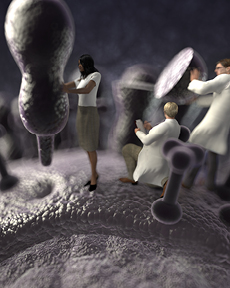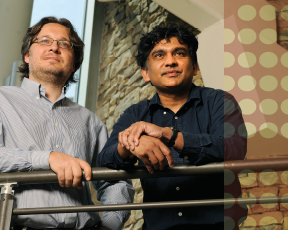Constructing a Better Vaccine
Emory scientists are deconstructing viruses to find the keys to improve longevity and efficacy of vaccines
By Martha Nolan McKenzie | Illustrations by Justin Metz
British doctor Edward Jenner is credited with creating the first vaccine in the 1790s when he inoculated a hapless young boy with cowpox and then exposed him to smallpox. The boy did not fall ill with the dreaded disease, and modern vaccinology was born.
Since that day, countless vaccines have been created, reshaping the public health landscape. “Today a child gets his first vaccine on the day he is born, and he will go on getting vaccines for the rest of his life,” says Bali Pulendran, a pathologist and a researcher at the Emory Vaccine Center. “Many of these vaccines are highly successful in controlling infectious diseases that plagued mankind for ages.”
Yet vaccinology can still come up short, as the 2009 H1N1 pandemic, which resulted in about 16,500 deaths worldwide, painfully clarified. Some diseases, such as malaria, HIV, and tuberculosis, have proven resistant to efforts to develop an effective vaccine. And some vaccines work well in certain segments of the population but fail to provide adequate protection in others, such as the elderly.
Emory researchers are seeking solutions to these vexing problems. They have identified broadly protective antibodies in patients infected with the 2009 H1N1 virus—a promising first step toward a universal flu vaccine. They are testing man-made nanoparticles to boost the potency and longevity of other vaccines. And they are using new technology to develop biomarkers to predict a vaccine’s eventual effectiveness within a day or two of vaccination.
“There are places doing great immunology research, and there are institutions developing vaccines,” says Pulendran. “What is unique here at the Emory Vaccine Center is that we really try to fuse those two efforts. We have top-notch immunologists who are focusing their research on vaccine-related problems.
“We also have the clinical infrastructure and expertise for vaccine testing and evaluation at the Hope Clinic,” continues Pulendran. “We have access to the public health expertise at the CDC, and we have a close collaborative relationship with Georgia Tech, which is probably one of the best bioengineering places in the world. So Emory is a special place for immunology and vaccinology.”
Universal flu vaccine
 |
Ideally, a vaccine should provide protection for a lifetime, or at least for several decades. And many do. But flu virus has proved an elusive prey for vaccinologists, endlessly morphing into new strains that require new vaccines each year. Researchers at the vaccine center, in collaboration with the University of Chicago, have taken a significant step along the path that could lead to development of a single vaccine to provide permanent immunity to all strains of influenza.
They discovered that patients with the 2009 H1N1 flu strain produced antibodies that were protective against a wide variety of flu strains. In fact, these antibodies could protect against all the seasonal H1N1 flu strains from the past decade, the devastating “Spanish flu” strain of 1918, and a pathogenic H5N1 avian flu strain.
The finding was quite a surprise. Normally a flu infection leads to production of antibodies that are specific to that particular strain—they are useless against a different flu strain. The fact that the 2009 H1N1 strain produced such broadly protective antibodies suggests that scientists might be able to reproduce that response with a vaccine, essentially creating a universal flu vaccine.
But first scientists have to understand exactly how the 2009 H1N1 antibodies work their magic. They discovered that these antibodies attack flu differently from the way other antibodies do, aiming at a different target. Protective immune response is directed against a protein on the virus called hemagglutinin, or HA. This protein is responsible for binding the virus to other cells and infecting them. When you knock out the infective capacity of the HA, you knock out the virus.
The actual HA molecule resembles a tree, with a long stalk area and a rounded head. Almost all antibodies attack the head region, which is the section that binds the virus to other cells. However, the head is also the section that is constantly changing, evolving into new strains. An H1N1 antibody, or vaccine, that recognized and attacked the virus one year would not recognize it again one or two years later.
The antibodies produced by those infected with the 2009 H1N1 virus, however, preferentially attacked the stalk section of the HA. This section is much more stable than the head.
“Since these antibodies attach to the stalk, which doesn’t really change from year to year, they were able to recognize all the H1N1 strains from the past decade, including even older ones from the 1960s and 1970s and even the 1918 strain,” says Jens Wrammert, an Emory microbiologist and immunologist. The task ahead for scientists is to design a completely new type of vaccine that targets this stalk region of the HA. “If we could do that, it would suggest that we could make a vaccine that was effective against most flu strains and last, if not a lifetime, at least a very long time,” says Wrammert.
Stimulate long-lasting immunity
The Holy Grail for vaccine scientists is to create vaccines that provide protection for a lifetime. And many live-virus vaccines, such as smallpox and yellow fever, do just that. Yet scientists don’t understand how these vaccines work. Perhaps more important, they also don’t understand why some diseases, such as malaria, HIV, and tuberculosis, remain resistant to vaccines. If researchers could discover how successful vaccines like yellow fever stimulate protective immune responses, they might be able to apply that knowledge to design new vaccines against resistant diseases.
Several years ago, Pulendran and researchers in his lab found that yellow fever vaccine triggered four different receptors, called TOLL-like receptors (TLRs), in the innate immune system. “TLRs are like the sixth sense in our bodies because they sense viruses and bacteria and convey this information to stimulate the immune response,” says Pulendran. “But we wondered, why does the yellow fever vaccine trigger four? Why not just one? Was the clue to its great immune response that it activated more than one TLR?”
To test this theory, Pulendran’s lab created a nanoparticle that looked like a virus and was studded with molecules that activated two different TLRs. The particle contained two components, both already FDA-approved for human use. One was MPL, an adjuvant already licensed for use with the cervical cancer vaccine and shown to activate one TLR. The second is a small molecule called imiquimod (R837), which activates another TLR. It too has been licensed for clinical use to treat certain diseases of the skin but not for vaccines. The particle itself is made from PLGA, poly(lactic acid)-co-(glycolic acid), a synthetic polymer used for biodegradable grafts and sutures.
The lab first tested the nanoparticle-based vaccines in mice, inoculating the animals with a flu vaccine containing the particle. Nanoparticles that activated both TLRs stimulated greater and longer-lasting immune responses than those that activated only one TLR. Strikingly, the former could stimulate immune responses that lasted nearly 500 days—the lifespan of a mouse. The researchers also injected monkeys with a swine flu vaccine with the particle, generating an immune response greater than that generated in monkeys given a dose of the inactivated virus without the nanoparticle. These results, which were published recently in Nature, address one of the more important questions in vaccinology.
Predicting vaccine efficacy
|
|
A major problem with vaccines is that you have to wait until the person is actually exposed to the virus or pathogen to be sure they really work. But what if you could test a person a day after being vaccinated and tell whether or not that vaccine was going to give effective protection?
Pulendran’s lab is trying to devise such a test. Different fields of biology have been using new approaches, such as microarray analysis, to measure the expression of all 25,000 genes in our genome in one instant by putting a cell on a gene chip. “A computer can scan this chip and say, ‘Gene #15,891 is turned on. Gene #2 is turned on. Gene #9,678 is switched off,’” says Pulendran.
Although this technology had been applied to identifying biomarkers of cancer progression, it had not been applied to vaccines, until recently. Pulendran’s lab vaccinated a group of 15 healthy, young adults with the yellow fever vaccine. Scientists drew blood from the subjects before the vaccine, one day after, three days after, and at varying intervals for one year, studying the T cell and antibody responses. They saw a striking variation in these responses among individuals, and they were able to identify gene signatures that correlated to these responses. To determine whether these signatures could, in fact, predict immune responses, they vaccinated a second group and were able to predict with up to 90% accuracy who would develop a strong immune response.
These results suggest that vaccine immunity can indeed be predicted. Such a test would be a huge benefit to populations who typically don’t mount protective immune responses, such as the elderly and those with autoimmune disorders. It also could speed up the often-glacial process of clinical trials. “In some clinical trials, you are working with thousands of people over two to five years or more before you have data on effectiveness,” says Pulendran. “A biomarker that could predict vaccine effectiveness could shorten that process considerably.”
Pulendran’s lab is currently working to establish biomarkers for vaccines for flu, pneumonia, malaria, and shingles. “This topic seems to have captured the imagination of the field, and there are a lot of people working on it right now,” he says.
But Pulendran is confidant that Emory will continue to lead the way in vaccine research. He says. “If Louis Pasteur were living today, he’d want to be at Emory!” EM




